
Pr2is/Getty Images
Thanks to a certain celebrity couple’s engagement photos earlier this year, pink gardens are primed to become very popular. Pink is a gorgeous color in the garden, blending well with both warm and cool color palettes, and there’s a huge range of pink flowers from pastels to vibrant hot pinks. Who doesn’t enjoy pink flowers in the spring after the bleakness of winter? You can have a garden full of romantic pink blooms in spring with easy-to-plant bulbs that will give you months of color from March through June: Here are some of my favorites.
Planting flower bulbs in the fall is one task most gardeners enjoy because it generates some excitement about spring’s return. Some of the most popular bulbs to plant in fall include daffodils, tulips, Dutch hyacinths, grape hyacinths, squill, and alliums, and all of these have many pink options. They’re easy to plant, and if they’re in a suitable spot, will increase every year, so after several years, you can divide the clumps and plant them in other spots, too.
These bulbs are all winter hardy for USDA Zones 5 through 9, and some are hardy for even colder areas (check the packaging or catalog descriptions). Spring-blooming bulbs can be planted anytime after mid-September, and some, like tulips, can be planted as late as early December, if the ground is still workable. Check the pack and website directions for proper planting depths and specific tips.
‘Pink Charm’ daffodils
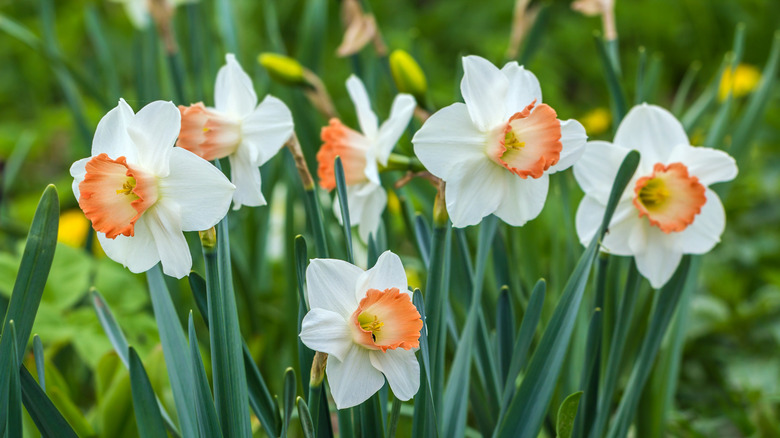
S.O.E/Shutterstock
Pink daffodils (Narcissus) are usually closer to peach or apricot than pink, but they add some unique color possibilities to the spring garden. ‘Pink Charm’ is one of my favorites: A large-cupped daffodil with white outer petals and a pale peach cup tipped with a darker coral pink. Simply lovely! Try to plant daffodils in early October, so they can get established before the nights of hard frost become more frequent (this helps prevent bulb rot). They like partial to full sun, and should be planted 8 to 10 inches deep in well-drained soil.
‘Pink Pearl’ hyacinths
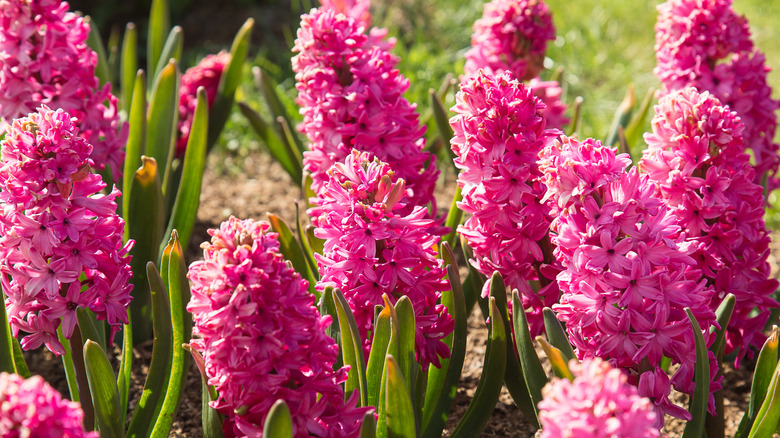
Andrejs Marcenko/Shutterstock
Dutch hyacinths (Hyacinth orientalis) are wonderfully fragrant (just one cut flower can perfume an entire room) and come in a rainbow of gorgeous colors, including a number of pinks. ‘Pink Pearl’ has vivid medium pink flowers with edges of lighter pink: the colors really glow in the garden. They look beautiful planted with pale blue Dutch hyacinths (like ‘Delft Blue’ or ‘Blue Star’) or light blue grape hyacinths like ‘Valerie Finnis’ or ‘Baby Breath.’
‘Fondant’ hyacinths
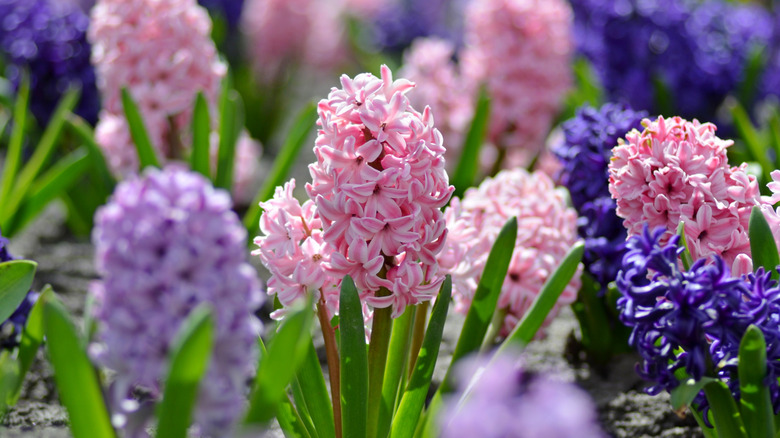
Belevantseva/Getty Images
‘Fondant’ hyacinths are similar to ‘Pink Pearl’ hyacinths, as the flower petals also have lighter contrasting outer edges. The color tends to be a more uniform pastel pink, and looks gorgeous with darker blue hyacinths like ‘Peter Stuyvesant’ or ‘Blue Trophy.’ ‘Fondant’ also grows slightly taller (up to 14″), and blooms a bit earlier than ‘Pink Pearl.’ Watch for this fragrant charmer to start opening its flowers in early spring.
‘Salome’ daffodils

Andrew Fletcher/Shutterstock
This is the first pink daffodil I ever grew, so it’s very special to me. ‘Salome’ has creamy white outer petals and a peachy yellow cup tipped with pale golden yellow that is simply charming. This is a large, robust daffodil that naturalizes well in flower beds or in woodland gardens (deer leave them alone!), and like other daffodils, will increase every year, giving you large clumps of bulbs to divide over time. It grows 14 to 16 inches tall, and starts to bloom in early to mid spring.
‘Pink Sunrise’ muscari
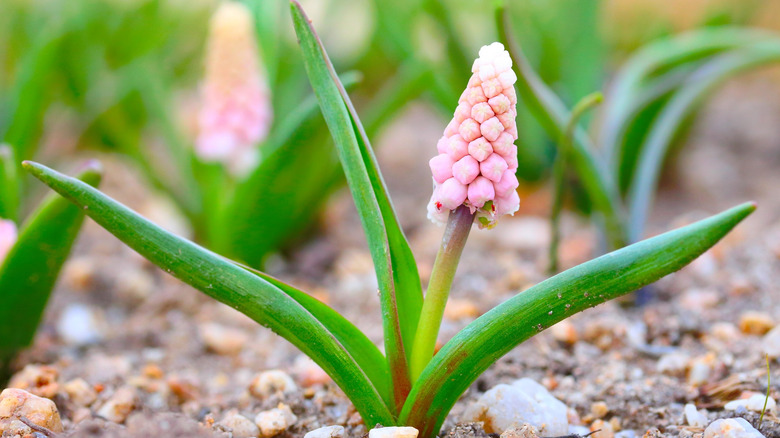
Kletr/Shutterstock
These uniquely colored muscari are a fairly recent introduction. Pastel-colored ‘Pink Sunrise’ muscari are a whole new look for grape hyacinths, which are usually blue or white. The bulbs increase every year, so even if you only plant a few, in several years’ time they will have doubled in volume. Try these planted alongside other mid-spring bloomers, like Dutch hyacinths (such as salmon-peach ‘Gypsy Queen’ or reddish-purple ‘Woodstock’), or Darwin hybrid tulips (like pale pink ‘Apricot Pride’ or golden-orange ‘Daydream’).
‘Replete’ daffodils
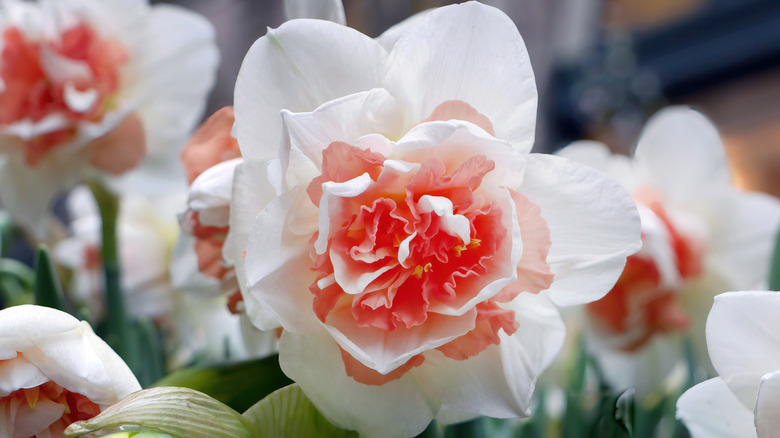
Darr.di/Shutterstock
Double-petaled daffodils look so luxurious in the garden, and many of them are fragrant, including this ivory and coral pink beauty. ‘Replete’ daffodils are hardy in USDA zones 3 through 8, grow 18 to 20 inches tall, and bloom for weeks starting in mid spring. Cooler temperatures will bring out this flower’s orange-pink tones, while warmer spring weather brings out its rose-pink hues; either way, it’s gorgeous.
Glory of the Snow

Ole Schoener/Shutterstock
These diminutive, star-shaped flowers wake up early in spring, hence the descriptive name ‘Glory of the Snow’ (Chionodoxa forbesii), because their April bloom time sometimes coincides with spring storms. They come in shades of pale blue, pink, and white, and are often sold as a mix of colors, but some gardeners (myself included) like to plant the different hues separately. You can order the pink ones from Blooming Bulb, and Van Engelen sells the ‘Pink Giant’ variety, which has pale lavender pink blooms.
‘Pink Impression’ tulips
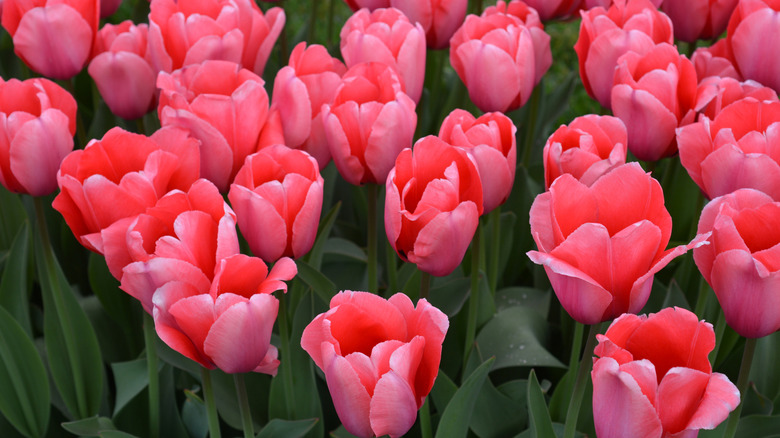
Nahhana/Shutterstock
‘Impression’ tulips are a subset of Darwin hybrid tulips, which are robust tulips that often return to bloom for several years, making them more perennial in nature than other tulips that only bloom once (like Triumph tulips and single late tulips). ‘Pink Impression’ is one of the most popular pink tulips for its vivid color, dramatic size, and repeat blooms. These flowers fill up the garden with color in spring and stand up well to windy and rainy weather.
‘Janis Joplin’ tulips
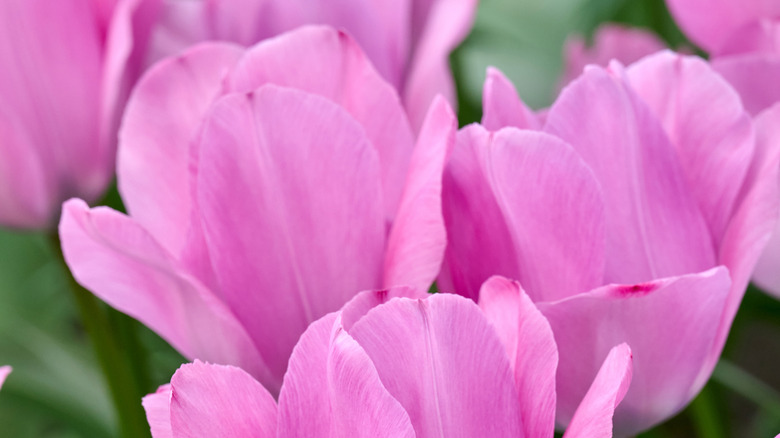
Henk Colijn/Shutterstock
I saw these ‘Janis Joplin’ tulips online a couple of years ago and had to try them. These Triumph tulips flower from late April to May, and only bloom once, but their delicate, gorgeous color (a luminous lavender pink touched with apricot) makes me happy. They’re medium tall (16 inches), and the curvy petals hold up well. Give them a prominent place in the garden to celebrate their unique beauty, and maybe play them a song by the great legendary singer they’re named after.
‘Amazing Parrot’ tulips

Alex Manders/Shutterstock
Parrot tulips are another variety that only blooms once, but their dramatic form makes them very popular among tulip enthusiasts. They have large blooms with ruffled, fringed petals and often display multiple colors on one flower. There are several pink parrot tulips available, but my newest favorite is the recently introduced hybrid ‘Amazing Parrot’ – a tulip with stunning tropical colors. It’s a medium rosy pink with peach and gold edges. Parrot tulips are real show-stoppers in the garden, so plant them where they can be admired.
‘Charlotte Bishop’ spring starflower
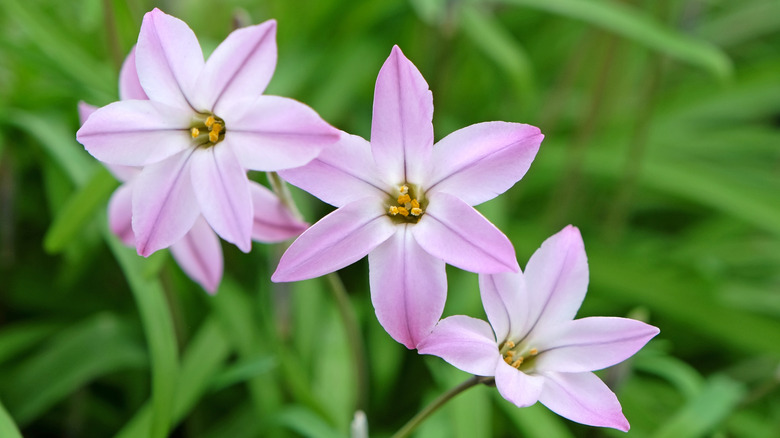
Alex Manders/Shutterstock
The ‘Charlotte Bishop’ spring starflower is the most reliable pink spring starflower (Ipheion). These small star-shaped flowers emerge in early spring and offer delicate color to brighten the cold days. Plant them in drifts in woodland gardens (they’ll increase in number each year) or at the front of beds. Hardy in USDA Zones 5 through 9, they’re reliable spring bloomers, and squirrels and other digging critters will leave them alone. They’re also lightly fragrant, and unlike larger bulbs, do well in containers.
‘Albert Heijn’ tulips
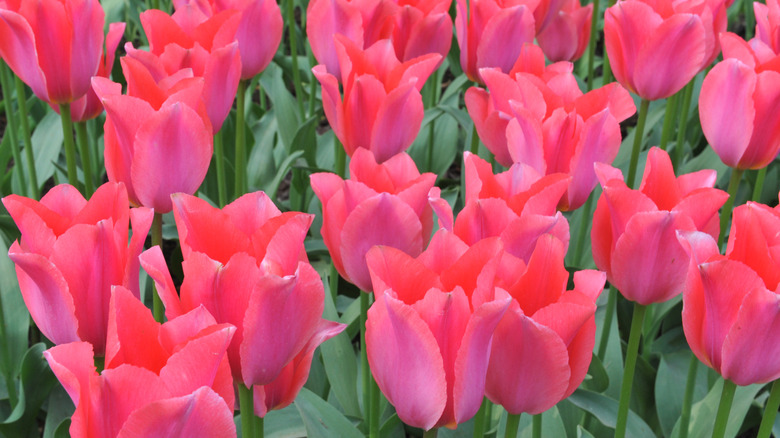
Sergey V Kalyakin/Shutterstock
This is one of my favorite pink tulips. They’re early bloomers, known as Emperor or Fosteriana tulips, and I’ve had them return to bloom reliably for several years. The warm pink petals of ‘Albert Heijn’ are curved with gentle points and have a subtle lavender overlay. Usually, they’re a pale pink, but I’ve seen them display brighter pink hues, also. As they mature, the petals will open wider and spread out.
‘Charmer’ windflowers
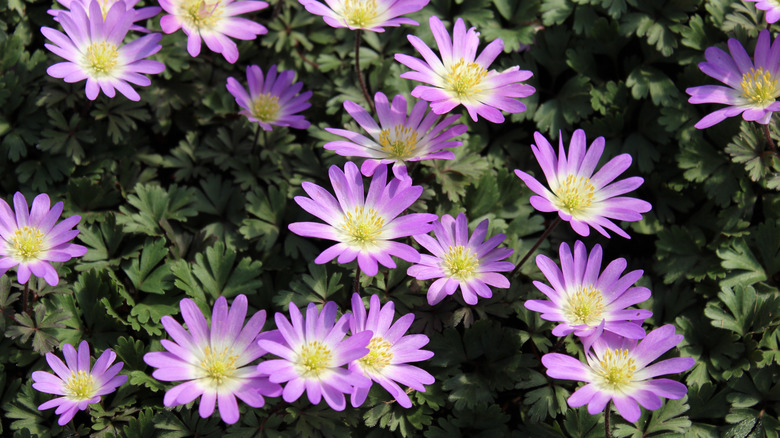
N.Stertz/Shutterstock
Windflowers (Anemone blanda) come in shades of pale violet, blue, pink, and white. They’re usually sold in mixed color batches, but you can also buy single colors. The bulbs are actually hard corms, planted in the fall. Once they’re established, windflowers are very reliable bloomers, but this may take a year or two. Plant them in rich, well-drained soil that’s not too acidic. They bloom fine in partial sun, and because they’re on short stems, plant them near the front of the border so they can shine.
Pink allium ‘Oreophilum’
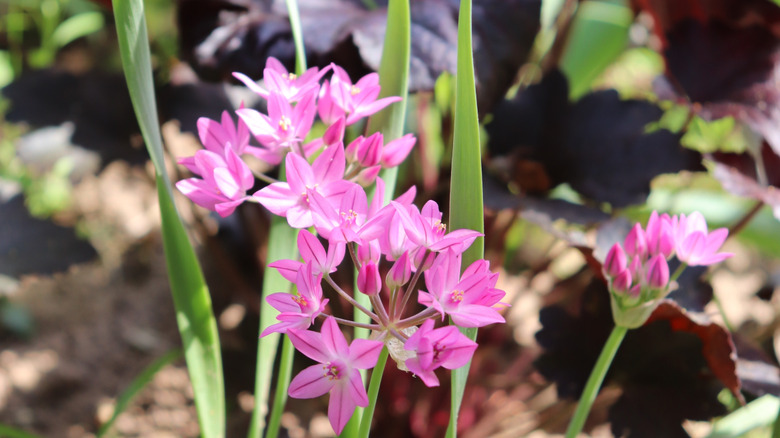
Galina Bolshakova 69/Shutterstock
This pink allium blooms for several weeks in mid to late spring. ‘Oreophilum’ (Allium Ostrowskianum) has warm, candy pink flowers and is also known as Alpine rosy bells, pink lily leek, and is sometimes called rosy garlic. Like most alliums, it has a slight oniony fragrance, so you may not want to plant it in containers next to fragrant bulbs. But these add lovely color to the spring flower bed, and look great in rock gardens. They’re also deer-resistant and tolerate poor soils.
‘Pink Diamond’ tulip

Alex Manders/Shutterstock
The ‘Pink Diamond’ tulip has a graceful, slender shape and gorgeous pale pink petals with subtle shading. This single late tulip variety blooms in May and makes a nice companion to other May-blooming flowers like bearded irises and peonies. This pink stunner is one of the taller tulips (24 to 30″), so it’s eye-catching further back in the border, especially if you plant at least six or seven of them together. I tend to plant tulips in clumps and not in rows, to create small bursts of color throughout the garden.
‘Bell Song’ jonquil
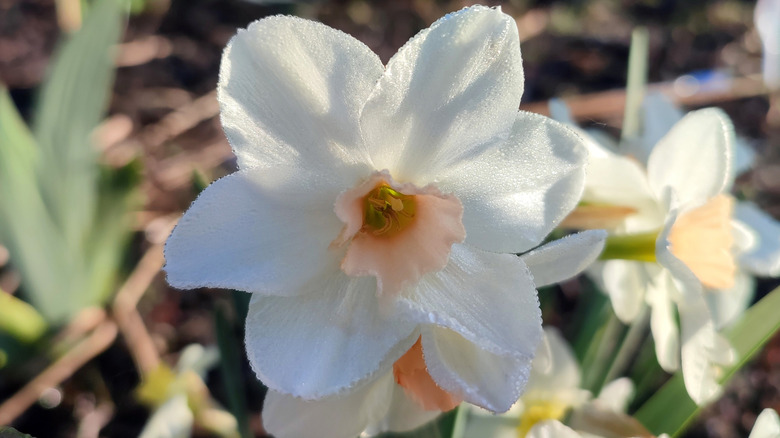
MarinaGrigorivna/Shutterstock
Jonquils are a type of daffodil that are somewhat smaller in size, and usually have more than one stem of blooms per flower. They’re also fragrant. This petite jonquil (12 to 14 inches high) provides lovely pastel color to the mid-spring garden and is a robust perennial that increases in number every year. ‘Bell Song’ has a small cup, but the pale, peachy-pink color attracts attention when planted in clumps or drifts.
‘Mariette’ tulip

Kathryn Roach/Shutterstock
This lily-flowering tulip has graceful petals that form an attractive shape, which holds up to wind and weather, and blooms late to light up the garden in May. ‘Mariette’ is a rosy pink hue that really stands out in the spring flower bed, and combines well with both pastel and bright colors. Try it planted near pale blue muscari (like ‘Valerie Finnis’), or with purple single late tulips like ‘Violet Beauty’ (lavender-blue), ‘Queen of Night’ (dark purple), or ‘Caravelle Design’ (rich purple).
‘Dainty Maid Pink’ Spanish bluebells

Natalia Greeske/Shutterstock
If you have some space to fill in your woodland garden, partial-shade-loving Spanish bluebells (Hyacinthoides hispanica) spread quickly through the garden. They do have a tendency to take over, so they do best planted by themselves and not with other flowers. But they’re a stunning sight when they bloom in spring, covered in nodding bells of blue, white, or pink. The pale orchid pink blooms of ‘Dainty Maid Pink’ or the rosy pink of ‘Rosabella’ will add cheery color when planted in long drifts by your driveway or throughout woodland areas.
‘Apricot Passion’ hyacinths
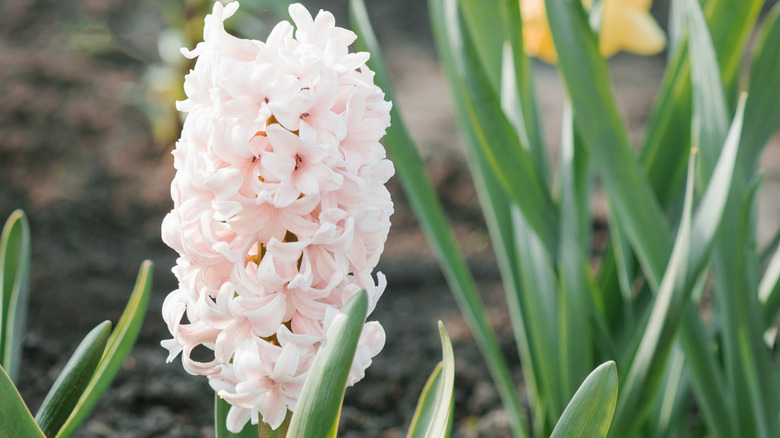
Chamomile_Olya/Shutterstock
This recently-introduced hyacinth is a fetching shade of pale peachy pink, in a pastel that is more delicate in tone than the peachy-salmon ‘Gypsy Queen.’ Pale colors can really light up the spring garden on a cloudy day: Try this hyacinth with lemon yellow daffodils (like ‘Lemon Glow’ or ‘Lemon Beauty’), pale blue muscari (like ‘Mountain Lady’ or ‘Baby Breath’), or pale pink tulips like ‘Pink Diamond’ or ‘Apricot Delight’.
‘Jan Bos’ hyacinths
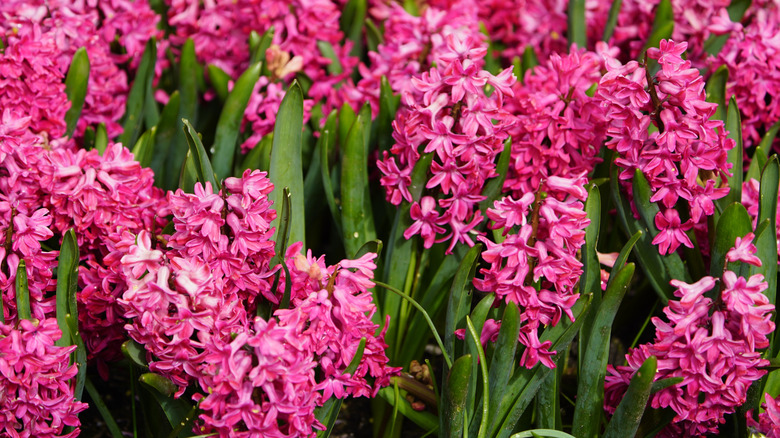
guentermanaus/Shutterstock
This heirloom Dutch hyacinth is a bold shade of hot pink and adds wonderful color to the spring bed. I find this one to be a reliable bloomer for several weeks. It looks great with light blue and dark purple flowers, as well as warmer colors like cream, yellow, and orange. Plant it with mixed pink tulips for a bright tapestry of pink spring blooms.
‘British Gamble’ daffodils
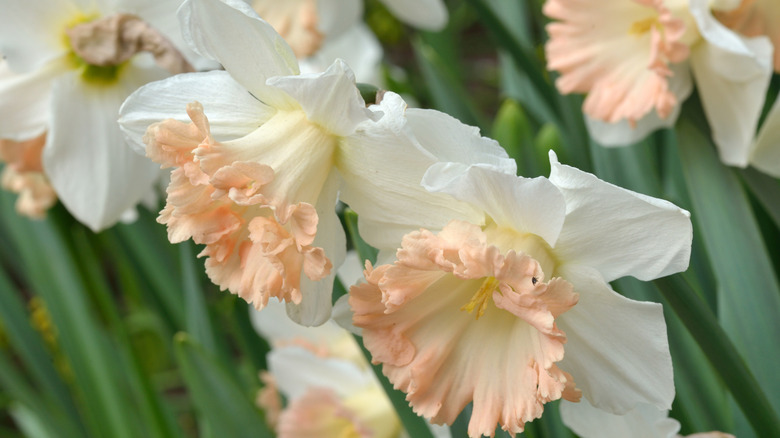
Walter Erhardt/Shutterstock
This is a very showy trumpet daffodil with a large frilly cup tipped with pale pink. The flowers are large and long-blooming, opening up in early spring and lasting several weeks. At 18 inches tall, these are a good size for the middle of the flower bed, or for edging a walkway. ‘British Gamble’ also makes an excellent cut flower. When cutting daffodils for a vase of mixed flowers, let them sit in water by themselves for a couple of hours to let the sap in the stems leach out a bit, as this can be toxic to other floral varieties.
Rosy squill
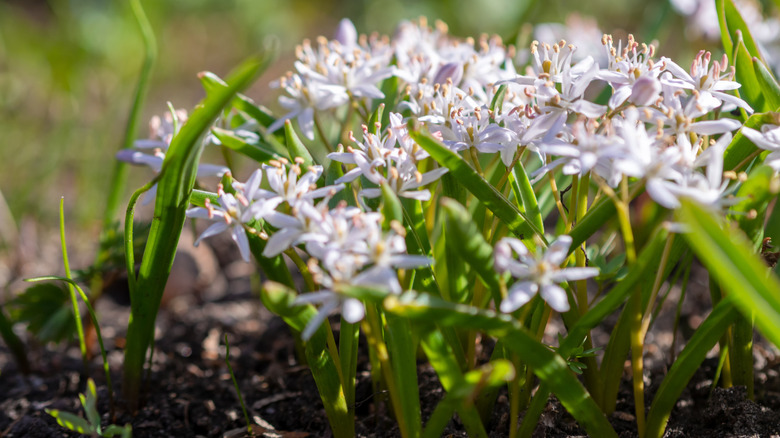
AndreyOzhegov/Shutterstock
Squill (Scilla) is a great bulb to plant in the lawn or in the very front of the flower bed. It wakes up very early in spring, sometimes in late winter, offering the welcome sight of delicate flowers after winter. Most folks are familiar with the cobalt blue squill: ‘Rosy Squill’ is a pale pink and looks lovely planted en masse. These bulbs naturalize well and will increase in number each year, spreading gently through the lawn until they form a pastel carpet of blooms that fades before it’s time to mow the grass.
‘Salmon Impression’ tulips
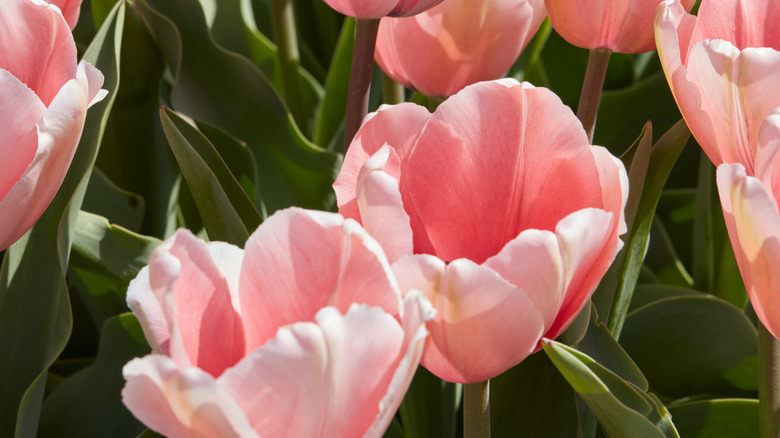
Andreaastes/Getty Images
These pale pink tulips have a touch of peach in their petals, and the goblet-shaped blooms glow with pastel color in spring. ‘Salmon Impression’ is a Darwin hybrid and will come back for several years in ideal conditions (full sun and well-drained soil). Like other ‘Impression’ tulips, these are large and lustrous, and stand up to rainy spring weather better than most of the other tulip varieties. Try them planted with orange tulips like ‘Ballerina’ or ‘Blushing Apeldoorn’ for a warm, glowing spring garden.

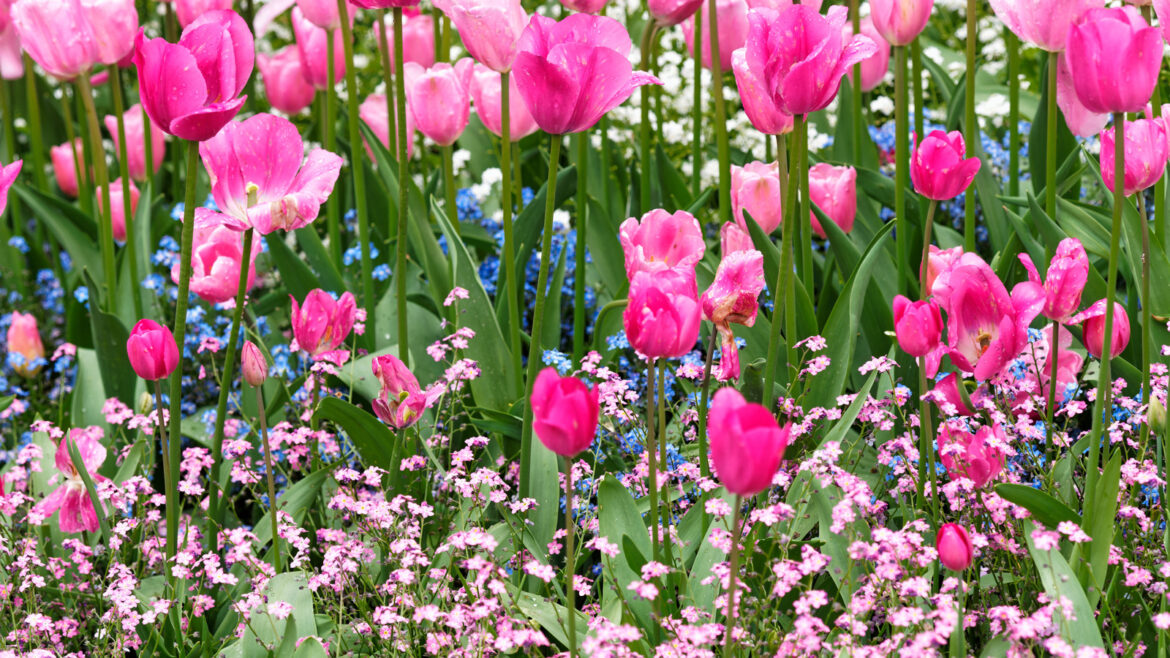
Comments are closed.